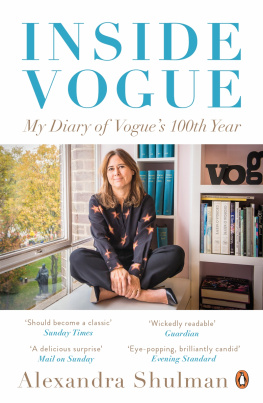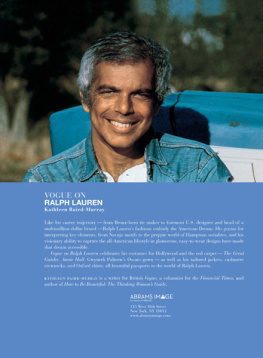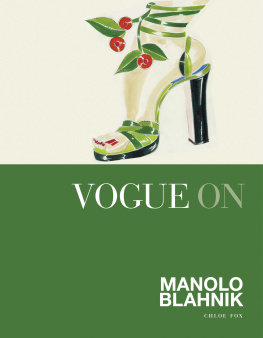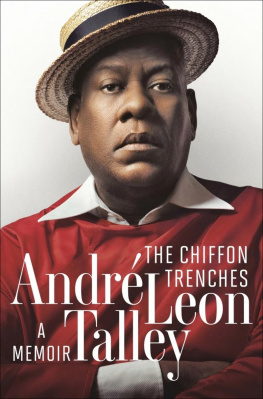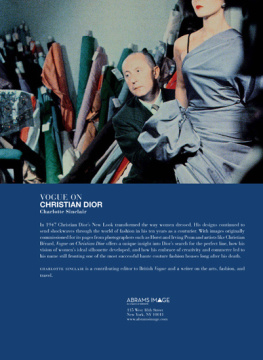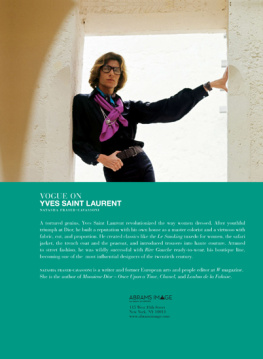By the same author
Can We Still Be Friends
The Parrots
Alexandra Shulman
INSIDE VOGUE
A Diary of My 100th Year
FIG TREE
UK | USA | Canada | Ireland | Australia
India | New Zealand | South Africa
Fig Tree is part of the Penguin Random House group of companies whose addresses can be found at global.penguinrandomhouse.com.
First published 2016
Copyright Alexandra Shulman, 2016
The moral right of the author has been asserted
Cover photo Francesco Guidicini
The permissions that appear constitute an extension of this copyright page
ISBN: 978-0-241-97836-8
For Sam and David
Authors Note
I kept a diary of Vogues Centenary year in part because I knew it would be worth remembering in detail, but also because writing a story has always helped me during times of tension and anxiety, both of which I anticipated heading my way. I wrote almost all of the entries first thing in the morning or when I got home from the office. Over these nine months, so much has changed both in my world at Vogue and in the world outside, but what I have written is my immediate impression of the days events at the time for better or worse.
There is a lot of detail about the workings of the magazine here. Were I writing a personal Dear Diary I might not have included this the system of department-store adjacencies, the process of fashion shoots, the sometimes tedious business of office meetings but I have put these details in to make the story more comprehensible and to give an insight into how a magazine like Vogue functions. Mainly, this is the story of one womans life during an extraordinary year.
Alexandra Shulman
July 2016
2015
September
1 September
Three nights ago, in a restaurant by the sea, just off a coastal road in Puglia, some children at the long family tables next to ours were playing with their pencil cases, lining up the coloured felt tips in order. Today, back in London, it is like the first day of term, and I wish I had a new box of coloured pens that I could bring in to work with me, and which were shiny and neat and full of promise. Though of what, I couldnt say.
The first of September was my fathers birthday. If he were still alive he would be 102 today. Instead his ashes were shot into the sky eleven years ago in a rocket my brother, Jason, made from Evening Standards, the newspaper where my father worked for over forty years. He loved being a journalist, having a soapbox and a public voice, whether that be theatre criticism or politics or anything, really just so long as he was heard. I dont feel that way about editing Vogue. Its Vogues voice, not mine. Although I do, of course, have a choice in what that voice says. After three weeks on holiday I feel disengaged, and not sure I have anything to say on any subject relevant to the magazine. It will take a few days to re-immerse.
This morning the streets are wet, and through the night I could hear the drip of water from the broken drainpipe outside our bedroom window. I put on a striped shirt from Zara that I bought before the holiday. Its refreshing to wear something new ammunition for the day ahead. I never usually wear shirts, but a shirt feels as if it has a clarity of purpose, which will be helpful. Even so, its strange: a costume rather than the holiday clothes of the past days. Before leaving for the office I go to Gails bakery down the road and buy croissants and a Chelsea bun for my son, Sam, whose flight home from New York is scheduled to arrive at ten thirty this morning. Hes been away for nine weeks. Im so excited to see him. Tonight Ill roast a chicken for us. I wont relax until I get the text saying hes landed.
7 September
Ive returned to work with five large projects to achieve: a Centenary issue, a big party to celebrate our 100 years, the 2016 Vogue Festival, the filming of a BBC2 documentary about the magazine, and the successful installation of an exhibition at the National Portrait Gallery. When I consider them all, I want to go back on holiday. This morning is the press launch for the Vogue 100 A Century of Style exhibition. The young and relatively new director of the National Portrait Gallery, Nicholas Cullinan, arrives, a little upset that he has just nicked the fabric of his very smart, slim, tailored blue suit. Richard Macer and Charlotte Rodriguez have now started filming the documentary and Charlotte holds a huge boom above the conversations, which is not entirely relaxing. I know I have to get used to them since I agreed to the film but at this early stage their presence is extremely unnerving.
The fashion entrepreneur Leon Max is sponsoring the show, and he and his pale-skinned, long-haired Ukrainian wife, Yana, are there, fresh from cruising round Italy. Leon says hes suffering from vertigo after spending so long on the boat, and hes concerned because in November he has a huge shoot at Easton Neston, his estate in Northamptonshire. He leans back as if to aim his gun to demonstrate how its making him feel sick with dizziness. I recommend some eye exercises I was once taught that are meant to train the brain, eye and ear to minimize dizziness, but I can see he isnt listening. Leon left Russia when he was seventeen and has made a fortune. Now his company is not only a fashion line called Max Studio but he manufactures for many enormous stores in the States. I once asked him how he made his money. I made some good investments early on, was his laconic reply. He has a broad Slavic face, and you have to earn your smiles.
Just before we go into the auditorium Nicholas takes me aside and tells me that he has met with the Duchess of Cambridges team, who have said theyre considering agreeing to my request for a cover shoot for the Centenary issue. This is amazing news and Im completely surprised. I had written to the duchess to put forward this idea but hadnt yet heard anything from her office and had thought it wasnt going to happen.
The question of what might be on the Centenary cover had been bothering me intermittently for at least a year. What could encapsulate a century? I didnt want to put a single model on (and not Kate Moss, as we so often have for these commemorative issues) and had been leaning towards the conceptual or typographic treatment we have also tried previously, such as a plain silver for the Millennium, which sold incredibly well. But the Duchess of Cambridge would unquestionably be the best bet. Of course her photo has been on the cover of many magazines, but she has never been shot for a magazine before, and with Vogues history of royal portraiture, she would be part of a continuum. I was trying to think of a twist that might appeal to her and remembered, literally as I wrote, that she is Patron of the National Portrait Gallery.
Nicholas says it sounds as if theyre keen to work with a young photographer for whom this would be a big opportunity. As he says it, I know this could be difficult to cast.

